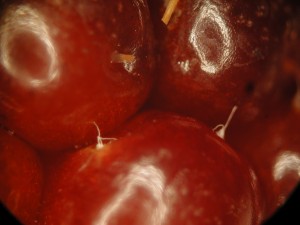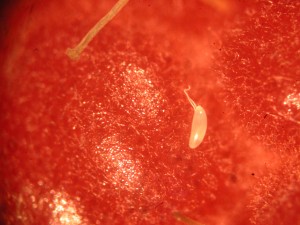
Brief: Spotted Wing Drosophila (SWD) males (5) and females (5) were observed in traps placed in our sweet cherry research orchard in the Hudson Valley, checked this morning, June 15th. A 40 fruit sample of fresh near ripe cherry showed no evidence of egg laying.
This find at the HVRL research orchard (Ulster County) in the third county in NYS in which SWD has been detected for the season. No SWD were caught in traps placed in a honeysuckle planting through the past week. Jim O’Connell. CCE Ulster County small fruit specialist, also found SWD in small fruit plantings in Ulster County today.
SWD numbers from traps remain low across Cornell Cooperative Extension SWD trap network trapping locations. Raspberry, blackberry, sweet and tart cherry, strawberry and blueberry are very susceptible to SWD as populations build over the coming weeks. Set traps this week to monitor for movement of SWD flies into ripening fruit of susceptible crops. Management should begin when SWD adults are found in commercial orchard or when eggs first appear in fruit.
SWD insecticides for stone fruits and grapes
SWD insecticides for treating dropped fruit
Introduction: Spotted-wingdrosophila, Drosophila suzukii Matsumura,is native to Asia, first detected in North American and Europe in 2008–2010 and the Hudson Valley of NY in 2011. Drosophila suzukii is a serious economic pest to stone and small fruits in New York. The adult female fly will lay her eggs within unripened fruit, often well before harvest, which has lead to severe crop loss.
Insecticide treatments should be applied at no longer then a seven-day interval in blueberry. Tighter intervals (3-4d) for cherry, raspberry and blackberry using the most effective materials available may be necessary under high pressure. Reapply in the event of rain. Select insecticides with (PHI) pre harvest intervals that work for your harvest and PYO marketing schedule. Rotate insecticides according to insecticide mode of action.
Sample fruit for infestation by selecting blush unripened fruit for evidence of egg laying and larval feeding. Small holes in berries where the eggs were laid will have white ‘respiratory horns’ or breathing tubes and may leak juice when the berry is gently squeezed; this is especially diagnostic on blueberry. Infested red raspberry fruit may leave a red juice stain on the berry receptacle when the fruit is picked. Fruit with small indents or bruises where the berry surface appears to have flattened or deflated may be damaged.
Chilling berries immediately after harvest. Place berries into cold storage using 32o – 33o F to slow or stop the development of larvae and eggs in the fruit. U-Pick customers should be encouraged to enjoy the berries on the day of harvest and keep berries refrigerated to improve fruit quality at home.
Management Details: There are only three effective classes of insecticides labeled for use to manage spotted wing drosophila on sweet cherry. They include the pyrethroids (IRAC Class 3): Asana XL 0.66EC (esfenvalarate) and Lambda-Cy 1EC (lambda-cyhalothrin); and the Spinosad class: Delegate 25WG (spinetoram) and Entrust 2SC and 80WP (spinosad); and the Diamides (IRAC 28) Exirel and Verdepryn. The organophosphate (IRAC Class 1): Imidan 70W (Phosmet) can only be used on tart cherry.
In conventional programs for cherry refer to the DTH chart to best accommodate management strategies up to harvest. From laboratory studies we have observed chilling of raspberry in 33-38F for 48-72hrs. to dramatically impact survival of larva and egg.
In SWD traps throughout the state, the adult has been observed in wild host plants including Tartarian Honeysuckle (Lonicera tatarica), and commercially managed sweet cherry, raspberry and blackberry, the latter two being a favored host of the SWD. Relative to blueberry and strawberry, raspberry and blackberry require considerably more intensive management strategies. In raspberry or blackberry patches where SWD have been captured and or fruit injury has been observed, management should begin at first adult capture followed by the first available application window to reduce the risk of initial adult egg laying. In these cultivars a tight management schedule of 3-4 days may be needed as populations continue to increase.

Given the increasing number of SWD finds we are seeing in the northeast, it would be wise to begin trapping efforts in cherry orchards, brambles and blueberry fields as flies increase from localized to regional populations. Although damage has occurred and may appear low in isolated Hudson Valley fruit farms, It is likely that SWD damage to small fruit will ramp up significantly over the upcoming week as temperatures rise and adults establish and build in population across the region.
Monitoring for SWD adults: Employing traps to monitor the first emergence of the adult on your farm is the most effect method to determine the start of SWD management. Traps can be made of red plastic 16 oz. solo cups and lids. Traps can be baited with apple cider vinegar (ACV), as the attractant killing solution. Approximately 30, 1/8″ holes, are drilled around the top 3/4 of the cup, leaving a 3′ gap to pour out the ACV solution in a strip of 2″ x 2″ netting to access the number of captured flies. A yeast, flour & sugar bait mixed with water needs to be added to a smaller container (5.0 oz.or so) fixed position cup along the top edge. Additional trap manufacturing information.
Conventional and Organic Management Options for NYS grown small fruit: Fewer tools are available for organic management of the SWD. Organic Management of Spotted Wing Drosophila can be enhanced through the use of various tactics and strategies. These include:
1. Optimizing organic plant protectant timings, rotation of insecticide and use of feeding enhancements (sugars) and biological controls, to establish the best possible use of current options for SWD management while reducing the impact on pollinators and non-target natural enemies.
2. Monitor the SWD to begin management at the onset of adult activity.
3. Employ cultural management practices including organic attract and kill, netted exclusion of plant canopy, address sanitation and orchard / berry floor management to reduce infestation and population buildup.
4. Develop harvest and cold storage system to reduce berry infestation.

Cultural control: Rotating plots within a block may be needed to maintain daily harvesting while cleaning the brambles of all fruit to reset management and eliminate eggs and larva in fruit as an important part of late season management strategies. Removal and complete destruction of infested berries will also reduce newly developing populations to aid in management. Keeping fruit cold (34-38F) directly after harvest will arrest egg and larval development. Prolonged exposure to these low temperatures for 3-4d will dramatically reduce egg and larva survival.
Additional SWD Resources:
The Cornell Spotted Wing Drosophila web site hosts a map of the counties in which SWD is being trapped.



